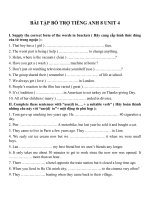Bài tập môn tiếng anh lớp 8 (29)
Bạn đang xem bản rút gọn của tài liệu. Xem và tải ngay bản đầy đủ của tài liệu tại đây (78.28 KB, 4 trang )
BÀI TẬP BỔ TRỢ TIẾNG ANH 8 UNIT 11
I. Fill in the blanks with the appropriate prepositions (Hãy đièn vào chỗ trống
những giới từ phù hợp):
1. They often stay ……………….home ……………………Sunday.
2. Her father nasks her not to stay ………………….late.
3. Don’t wait ………………………..them. They can’t go …………………..because
thay’re very busy.
4. You have to take ………………………… your hat when you are ………………the
house.
5. What is the looking …………………. ………………….the bed as he’s kneeling
down?
6. Why don’t you sit ……………………….? Do you want to stand ……………………
for along time?
7. Are your children afraid ………………dogs and mice?
8. All ………………….us had a great love …………………..our fatherland.
9. Look ……………………her dress. It is different ……………………yours.
10. The boys and girls are very excited …………………….the journey.
II. Correct the mistakes (Hãy sữa lỗi sai ):
1. I’d want you will drive the children to home on your car.
2. It’s very nicely of Henry to help us by these homeworks.
3. Would you mind to bring these chairs onto the room?
4. Could you like to go into the cinema beside us?
5. We go to have our room be decorated tomorrow.
6. How long it takes you to finish your houseworks?
7. Jack is boring because of his job is bored.
8. Everybody were surprising that he passes the exam.
9. The film is very interested. We’re interesting in it.
10. I was disappointing by the play. I expected it to would be more better.
III. Translate the following reading into Vietnamese (Hãy dịch bài đọc sau sang
tiếng Việt):
Jack and Jill saw a lot of things on their trip to the old castle in North England. It was a
long way, so when they came to the castle in the afternoon they were really tried. It was
very hot but the scenery was very beautiful and the castle was ancient. They enjoyed their
trip very much.
VI. Translate the following reading into English (Hãy dịch bài đọc sau sang tiếng
Anh):
Ngành du lịch hiện đại đã bắt đầu ở Việt Nam trong thời thuộc địa, nhưng nó xuống
dốc trầm trọng suốt nhiều năm dài xung đột sau Thế Chiến thứ hai. Với việc phát động
cải tổ vào năm 1986, chính phủ đã mở cửa cho du khách nước ngoài và cố gắng có phối
hợp để cải tiến những điều kiện thuận lợi thành phương tiện kiếm ra những đồng tiền
mạnh.
V. Read the following reading carefully, then complete it with the words given (Hãy
đọc kĩ bài đọc sau, sau đó hoàn thành nó với những từ cho sẵn): Museum, which,
National, situated, education, political, parks, century, Fine, University, and, museums.
EDUCATIONAL AND CULTURAL INSTITUTIONS
Hanoi has long been the center of (1) …………………………in the north. From 1442
to the late 19th (2) ………………………….., the city was a major site of Vietnam’s
periodic civil sevice examinations, (3) …………………………tested knowledge of
Confucianism, the foundation of the state’s (4) …………………………….system.
Today the city is home to 19 universities (5) ………………colleges, including the
University of Hanoi (1956), the Hanoi (6) ………………of Finance and Accounting
(1963), and the Hanoi (7) ……………………… Institute of Technology (1956). Hanoi’s
libraries and (8) …………………include the National Library of Vietnam (1919), the
Army (9) …………………………(1959), and the Vietnam Museum of (10)
…………………….Arts (1966). Numerous pagodas and several (11) …………………
are located in the city. Thu Le Park, (12) ………………………….in the Ba Dinh sector,
contains a small zoo.
VI. Read the sentences below carefully, the put them into their correct order (Hãy
đọc kĩ những câu sau, sau đó sắp xếp chúng theo đúng thứ tự):
1. The Mekong follows an irregular path across Southeast Asia to its mouth at the South
China Sea.
2. To combat this problem, the French installed dikes during the 20th century.
3. The Red River flows almost directly southeast from southern China into Vietnam’s
northwestern highlands.
4. Among Vietnam’s noteworthy smaller rivers are the Huong River (Perfume River) at
Hue and the Ka Long O River near Vinh.
5. Today, an intricate system of diskes and canals help prevent flooding of the Mekong
and Red River deltas.
6. Vietnam’s two major rivers are the Red River in the north and the Mekong River in the
south, both of which are navigable for their entire lengths within Vietnam.
7. Farming in much of the Mekong Delta was once impossible because salt water from
the South China Sea would periodically cover the low-lying land.
VII. Read the passage below carefully and then answer the questions (Hãy đọc kĩ
bài đọc sau, rồi trả lời câu hỏi):
LITERATURE
Before French colonial rule, literature in Vietnam was divided into two styles: a
classical style based on the Chinese model and a vernacular one based on local themes
and genres. Classical literature was written in literary Chineseand took the form of
poetry, history, and essays. Vernacular literature was written in chu nơm and took the
form of poety or verse novels. French colonial rule significantly influenced Vietnamese
literature. Drama, poety, and novels began to be written in quoc ngu and imitated
Western models. This trend continued in the South after the country was divided in 1954.
In the North, a new form of literature, called socialist realsm, developed …
1. How many styles of literature were there before French colonial rule?
2. What were they?
3. Which form did classical literature take ?
4. What about vernacular literature?
5. What was Vietnamese literature significantly influenced by ?
6. What began to be written in quoc ngu?
7. When did this trend continue in the South?
8. What developed in the North?









